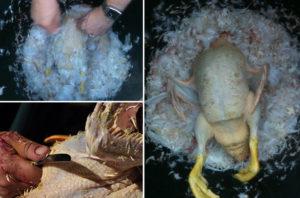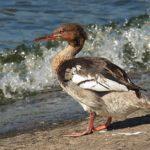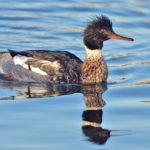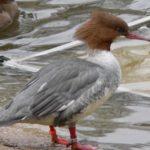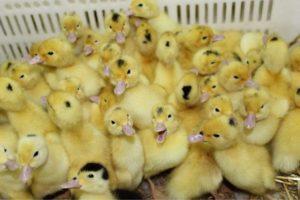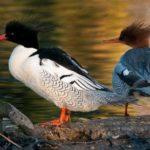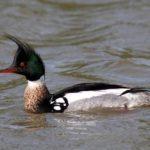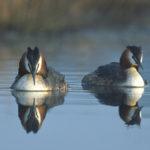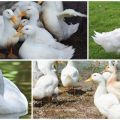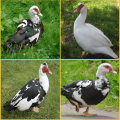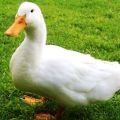Description of wild ducks with a crest and a sharp beak, the habitat of mergansers
There are many species of ducks in nature. The merganser is considered one of the largest. It is a sturdy duck about the size of a medium goose, with a crest and a sharp beak decorated with a series of notches. This immediately indicates the type of feeding of the bird, since such a device helps to capture and hold small fish, direct it to the throat and swallow it. Mergansers are a whole genus of waterfowl with common characteristics. In Russia, two types are widespread: the scaly and long-nosed merganser.
The origin and description of the merganser duck
It is a large diving duck, larger than the mallard - the most common member of the duck family. Mergansers are a separate genus of this family, which includes 4 now living species and one extinct a century ago. All of these ducks are considered rare or very rare, but their total number at the moment does not cause concern among environmentalists. Similar species also include slugs and crested mergansers.
Mergansers weigh from 900 grams (females) to more than 2 kilograms (males). Drakes are brightly colored, distinguished by a black head and back, a dark gray part at the tail. The rest of the body is white with the finest pinkish tinge. The duck is grayish-ash above, white below, its head is brownish-red.
Birds have orange-red beaks, like paws. The edges of the beak are equipped with special notches that help catch and hold slippery fish. From a distance it seems that the mergansers have beaks with teeth. Because of this, the people often call the bird a bison, and due to its long neck and the habit of eating fish, it is confused with a cormorant.
Habitat
This wild duck lives in northern European states, in Russia and America, as well as in parts of Japan. They prefer to choose the boundaries of wooded areas, stay close to water, because they are waterfowl and feed mainly on fish, small invertebrates and crustaceans.

Various types of merganser ducks are found in the tundra and forest-tundra, as well as in mountainous areas, for example, in the Alps or in the Scandinavian mountains. They migrate not to the tropics, but to the middle zone, not descending south of the steppes and forest-steppes on the coast of the Black and Caspian Seas.
Little ducks are cautious birds, so they try to choose open water bodies that are not overgrown with lush vegetation.For takeoff, they need a large body of water, so they cannot be found on small ponds, lakes and rivers.
What does it eat?
Gourmets with a delicate taste can envy the diet of merganser ducks. These birds prefer to feed on rather large fish, up to 25 centimeters long. From river fish, ducks choose trout and small salmon, as well as grayling, pike, roach, eel and many others. When they are on the sea coasts, in estuaries of rivers and on estuaries, they catch herring and other sea fish that are suitable for them in size.
The following types of food are also used:
- Shellfish.
- Crustaceans.
- Insects.
- Worms and so on.
Hunting of merganser ducks looks original and unusual. First, they are half submerged in the water, looking for prey, and then they dive, helping themselves with their webbed paws like flippers. It is because of this behavior that merganser ducks are often confused with cormorants.
Character and lifestyle of the duck
Mergansers are migratory or partially migratory birds. They go to winter in warm countries in October, early November, but return to their habitable places early, already in February. Flying away, ducks form huge flocks numbering hundreds of individuals, and return in small groups of no more than two dozen birds. In warm weather in mild winters with little snow, most mergansers do not fly south at all.
Those populations that live in the southern regions make the so-called vertical migration, moving over small distances.
These large birds are distinguished by a calm character, but on occasion, ducks can fend for themselves, because with their long red beak they not only successfully catch a rather big fish, but are also able to pierce the strong shell of crayfish.
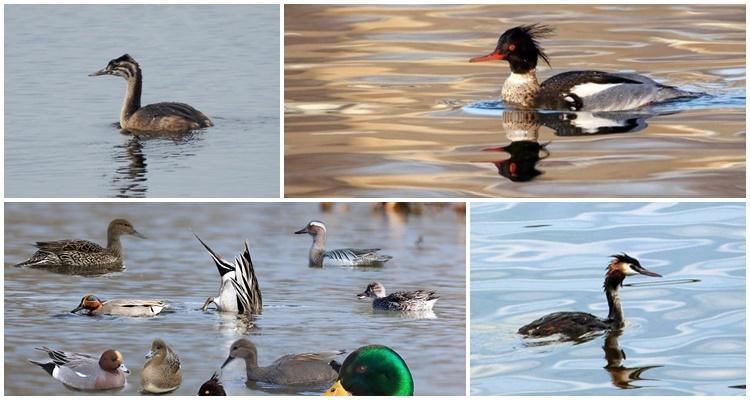
Social structure and reproduction
Sexual maturity in merganser ducks occurs at 2 years. The marriage ceremony is very beautiful and unusual. A male in a spectacular bright outfit performs an original dance in front of a selected female. These ducks rarely form stable pairs. Usually the female incubates the clutch, and the drake does not take any part in the fate of the offspring. Most often, it just disappears after the end of the mating season. The female lays from 8 to 12 eggs of a white or cream shade. Nests are arranged in hollows, females choose a place for them, since males do not take any part in raising offspring.
If there are no suitable hollow trees in the vicinity, ducks can make a nest in the rocks, but they try to avoid dense thickets and tall grass, as predators can easily sneak up on the clutch.
Females differ not only in color from males, but also in the length of the feathers on the back of the head. They are thicker and shorter than those of drakes. During the nesting period, ducks pluck out their own plumage - fluff from the breast, which is used to line the litter under the masonry.
Ducklings are at first very similar in color to their mother, only covered with soft and delicate down. They stay in the nest for no more than 2 days, after which they become independent, they swim perfectly. They have a developed instinct to follow, so you can often see the following picture: a merganser duck is floating in the water, and behind it is a brood of fluffy ducklings lined up in a chain.
Natural enemies of the merganser ducks
These ducks are large and strong enough to resist even larger opponents. They are armed with a sharp, long and strong beak, equipped with a serrated edge, as dangerous as a saw. They can seriously injure them.
Basically, the enemies of the merganser ducks are people, but the following animals can also attack them:
- Foxes.
- Raccoon dogs.
- Domestic and feral dogs, if ducks venture to nest near villages and towns.
- Birds of prey - eagles, eagles, seagulls, crows, and so on.
Smaller predators, for example, mustelids or wild cats, cannot always cope with an adult duck, and even more so a drake. Most often, they destroy nests, attack chicks or sick, wounded birds. Also, some reptiles can attack a brood or clutch, and large fish themselves can attack the ducks, but this rarely happens.
Population and status of the species
Mergansers are rare species, in some countries - endangered. So far, nothing threatens their population, since the number is considered stable. However, in a number of countries, the merganser ducks are listed in the Red Book, for example, in Belarus and Lithuania. This is due to the fact that the number of birds on the territory of these states is small and constantly decreasing.
The situation is also related to the type of the population itself. If birds are sedentary, they are less endangered, and the number of mergansers remains stable. Migratory ducks are exposed to more hazards when they move from one place to another. Also, the biggest risk factor is human activities that destroy the nature and habitats of ducks.
